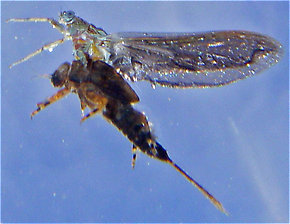Blog & Latest Updates
Fly Fishing Articles
Insects by Common Name


Mayfly Species Maccaffertium vicarium (March Brown)
Taxonomic Navigation -?-
Kingdom
Animalia (Animals)
» Phylum
Arthropoda (Arthropods)
» Class
Insecta (Insects)
» Order
Ephemeroptera (Mayflies)
» Species vicarium (March Brown)
Common Names
This species contains the two classic Eastern hatches formerly known as Stenonema vicarium and Stenonema fuscum, the "March Brown" and "Gray Fox." Entomologists have discovered that these mayflies belong to the same species, but they still display differences in appearance which the trout notice easily. Anglers should be prepared to imitate both types.
Where & When
This hatch begins in Pennsylvania and the Catskills in the middle of May. It peaks there in late May and early June. Throughout the rest of June and early July the hatch moves into the Adirondacks, New England, and the Upper Midwest.
The best action lasts from 1-3 weeks in most places. The traditional March Brown duns originally in the vicarium species are more common toward the beginning of the hatch, while the former-fuscom Gray Fox variety take over in the latter weeks.
Hatching Behavior
Time Of Day (?): Late morning through evening, usually peaking mid-afternoon; only late evening on hot days
Habitat: Slow water
Water Temperature: 55°F
The nymphs are reported to scurry from their fast-water habitat into slow pools and marginal water before emergence. Habitat: Slow water
Water Temperature: 55°F
March Browns take a long time (sometimes more than 30 seconds) to escape their shucks (
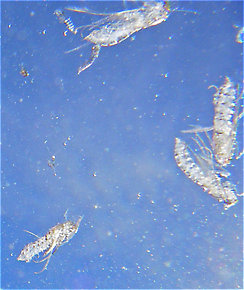
Here's an underwater view of the pupal shucks of several already-emerged Brachycentrus numerosus caddisflies.
These characteristics leave room for many types of flies: floating nymphs, emergers, low-riding duns, hackled duns, and cripple (Cripple: In fly fishing, a cripple is any insect which has been injured or deformed so that it cannot escape the water. This may include stillborn emergers or fully emerged adults which have been damaged, often by wind or waves, so that they can no longer fly. Trout often favor eating crippled insects.) patterns all have their place.
Spinner Behavior
Time Of Day: Late evening through dusk
March Browns return to the stream as spinners a few days after emerging. Spinners from many days of hatching typically mate together on select nights, and this makes for inconsistent but exceptionally good spinner falls.In Hatches II, Caucci and Nastasi write that the females oviposit by making repeated runs at the surface, dipping their abdomens briefly and rising up for another run. This contradicts the behaviors listed in Mayflies of Michigan Trout Streams, in which the Leonards say the females may drop their eggs from the air or release them as they fall spent (Spent: The wing position of many aquatic insects when they fall on the water after mating. The wings of both sides lay flat on the water. The word may be used to describe insects with their wings in that position, as well as the position itself.). Readers are invited to share their experiences in the comments and clarify the spinner behavior.
Nymph Biology
Current Speed: All speeds, but best in fast water
Substrate: Everything from boulders to weeds to leaf drift (Leaf drift: The mass of dead leaves gathered on the bottom of the stream, sometimes stacked thick in still places like back eddies. Many aquatic invertebrates use the leaf drift for shelter and food. Most insects shred the leaves to digest the bacteria and plankton living on them, rather than digesting the leaves themselves.) to silt
Environmental Tolerance: Very tolerant of high temperature and slow water
In Mayflies, the Angler, and the Trout, Fred Arbona reports stomach samples indicating the importance of these nymphs.Substrate: Everything from boulders to weeds to leaf drift (Leaf drift: The mass of dead leaves gathered on the bottom of the stream, sometimes stacked thick in still places like back eddies. Many aquatic invertebrates use the leaf drift for shelter and food. Most insects shred the leaves to digest the bacteria and plankton living on them, rather than digesting the leaves themselves.) to silt
Environmental Tolerance: Very tolerant of high temperature and slow water
Trout appear to be aware of this phenomenon, for their stomachs will often be crammed with as many as 100 to 200 immature nymphs a week before the hatches will begin for the season.
Maccaffertium vicarium Fly Fishing Tips
This hatch often occurs simulatenously with more concentrated species, and fish may be selective to those. Although March Browns provide good action throughout much of the day, you should not let them distract you from higher-density hatches of smaller flies like Ephemerella invaria which the fish might take selectively instead.
Pictures of 19 Mayfly Specimens in the Species Maccaffertium vicarium:
Male Maccaffertium vicarium (March Brown) Mayfly Dun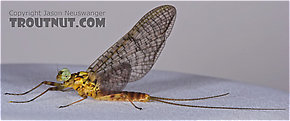 View 10 PicturesI collected this mayfly on the same trip as a female of the same species. After these photos it molted into a spinner. This is the form of Maccaffertium vicarium which anglers call the "Gray Fox."
View 10 PicturesI collected this mayfly on the same trip as a female of the same species. After these photos it molted into a spinner. This is the form of Maccaffertium vicarium which anglers call the "Gray Fox."
 View 10 PicturesI collected this mayfly on the same trip as a female of the same species. After these photos it molted into a spinner. This is the form of Maccaffertium vicarium which anglers call the "Gray Fox."
View 10 PicturesI collected this mayfly on the same trip as a female of the same species. After these photos it molted into a spinner. This is the form of Maccaffertium vicarium which anglers call the "Gray Fox."Collected May 28, 2005 from the Namekagon River in Wisconsin
Added to Troutnut.com by Troutnut on May 24, 2006
Added to Troutnut.com by Troutnut on May 24, 2006
Female Maccaffertium vicarium (March Brown) Mayfly Spinner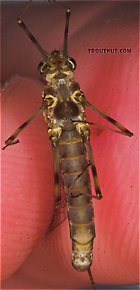 View 7 PicturesI collected this mayfly on the same trip as a male of the same species. They are Maccaffertium vicarium mayflies of the type formerly known as Stenonema fuscom, the "Gray Fox."
View 7 PicturesI collected this mayfly on the same trip as a male of the same species. They are Maccaffertium vicarium mayflies of the type formerly known as Stenonema fuscom, the "Gray Fox."
 View 7 PicturesI collected this mayfly on the same trip as a male of the same species. They are Maccaffertium vicarium mayflies of the type formerly known as Stenonema fuscom, the "Gray Fox."
View 7 PicturesI collected this mayfly on the same trip as a male of the same species. They are Maccaffertium vicarium mayflies of the type formerly known as Stenonema fuscom, the "Gray Fox."Collected May 28, 2005 from the Namekagon River in Wisconsin
Added to Troutnut.com by Troutnut on May 24, 2006
Added to Troutnut.com by Troutnut on May 24, 2006
Maccaffertium vicarium (March Brown) Mayfly Nymph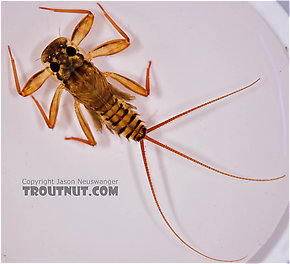 View 5 Pictures
View 5 Pictures
 View 5 Pictures
View 5 PicturesCollected April 19, 2006 from the Beaverkill River in New York
Added to Troutnut.com by Troutnut on April 21, 2006
Added to Troutnut.com by Troutnut on April 21, 2006
Recent Discussions of Maccaffertium vicarium
2 tails or 3 1 Reply »
I notice that while the dun, nymph, and spinner photos on the page are all listed as March Brown (maccaffertium vicarium). While the coloration patterns all seem to follow other March Browns I have seen, I notice that the winged flies pictures all have 2 tails, but the nymphs in the photos have 3. I was under the impression this species was a 2 tailed mayfly. Is the nymph mislabelled?
Replydiff between march brown &gray fox 7 Replies »i know that gray foxs and march browns are classified in the same family but what are the differences ? what is the color differences are both bodies the same color tan ?
ReplyYour Thoughts On Maccaffertium vicarium:
Top 10 Fly Hatches
Top Gift Shop Designs
Eat mayflies.
Top Insect Specimens
Miscellaneous Sites
Troutnut.com is copyright © 2004-2024 Jason
Neuswanger (email Jason). See my FAQ for information about use of my images.
 privacy policy
privacy policy

